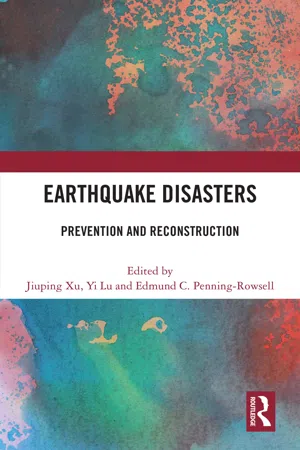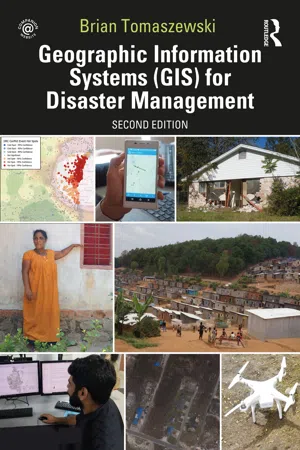Geography
Earthquake Hazard Management
Earthquake hazard management involves the assessment, mitigation, and response to the risks posed by earthquakes. It encompasses measures such as land-use planning, building codes, public education, and emergency preparedness to minimize the impact of earthquakes on human populations and infrastructure. Effective earthquake hazard management aims to reduce the potential for loss of life and property damage associated with seismic events.
Written by Perlego with AI-assistance
3 Key excerpts on "Earthquake Hazard Management"
Learn about this page
Index pages curate the most relevant extracts from our library of academic textbooks. They’ve been created using an in-house natural language model (NLM), each adding context and meaning to key research topics.
- eBook - ePub
Earthquake Disasters
Prevention and Reconstruction
- Jiuping Xu, Yi Lu, Edmund C. Penning-Rowsell, Jiuping Xu, Yi Lu, Edmund C. Penning-Rowsell(Authors)
- 2021(Publication Date)
- Routledge(Publisher)
The geo-genetic status of earthquake-related hazards and the role of human and policy dimensions in impact mitigation Aftab Alam KhanABSTRACT Earthquakes occur in and around active lithospheric-plate margins that are located both in diverging and converging plate-settings. New fault rupture or old active fault reactivation can cause ground shaking, land deformation, land subsidence, landslides, and mass avalanches. The relevant locations of major risk centres around the world are well known. However, the parameters such as trend, pattern, frequency and magnitude are highly variable and very difficult to determine and predict. One result is that many fundamental and universal scientific achievements for mitigating earthquake hazard have often failed in protecting and safe-guarding human life and property. Although naturally occurring events cannot be prevented nevertheless loss of life and property damage could be minimized if an integrated effort and using the wisdom of the relevant professionals are practiced. A paradigm shift of the culture from post-disaster relief and rehabilitation to pre-disaster preparation and practice would reduce the level of destruction from an impending earthquake. Requisite pre-disaster physical planning and appropriate building measures, and pre- and post-disaster risk management should give special attention to public awareness programmes for loss mitigation. However, the fundamental requirement for such achievement is dedicated approach and commitment from the planner, practitioners and end-users of risk mitigation actions.Introduction
Earthquake hazard is a natural phenomenon that can cause multidimensional disasters. These dimensions need to be understood, including their seismic nature (Table 1 ),1 - Brian Tomaszewski(Author)
- 2020(Publication Date)
- Routledge(Publisher)
Chapter 8 , mitigation activities are often interwoven into disaster-recovery activities as the recovery process is generally an opportune time for implementing disaster-mitigation measures. Disaster mitigation has been defined as “[t]he capabilities necessary to reduce loss of life and property by lessening the impact of disasters” (United States Department of Homeland Security 2016, 1). GIS can play a particularly important role in disaster-mitigation activities through the modeling of hazard and risk scenarios to identify potential physical, virtual, and social vulnerabilities that can ideally be mitigated or reduced through increased resilience efforts. As an example using earthquake risks, GIS data layers can be created that inventory housing characteristics such as building material and structural types in relation to the location of earthquake fault lines and landslide risks to determine how vulnerable the built environment is to potential earthquakes (Kamp et al. 2008; Environmental Systems Research Institute 2007). Such determinations can then be used to inform decision-making as to which buildings might require additional reinforcements to withstand earthquakes or will require higher insurance to recover losses in the event of an earthquake.Like all disaster management cycle phases, disaster mitigation is no different in that the use of GIS for disaster mitigation will be sensitive to the nuances and idiosyncrasies of the underlying people, places, culture, history, and overall geographic context being represented and analyzed in GIS. Furthermore, disaster mitigation for GIS often requires interdisciplinary connections across multiple areas such as earth science, sociology, and environmental science. These interdisciplinary connections between GIS and other disciplines are very important in that the use of GIS for disaster-mitigation activities must be guided by a clear understanding of the underlying scientific principles and processes inherent in a wide range of natural and man-made hazards, incident types, and underlying vulnerabilities. For example, the community that routinely faces flood hazards will need to have the perspective of a flood hydrologist to effectively use spatially oriented models that examine flood dynamics such as flood frequency and how these physical processes can have potential effects on the human environment; a community that is near a nuclear power plant will require the perspective of a nuclear engineer to understand the potential impacts of radioactive clouds in the event of a nuclear meltdown. Exercise 9-1: Creating a Displacement Natural Disaster Resilience Index in this chapter, which includes a video tutorial supported by the book’s companion website (gisfordisastermanagement.com), will provide you with skills on developing a displacement natural disaster resilience index that is fundamentally interdisciplinary in its design in terms of incorporating concepts from social science, earth science, and humanitarian practice.- eBook - ePub
Environmental Hazards and Resilience
Theory and Evidence
- Dennis J. Parker, Edmund C. Penning-Rowsell, Dennis J. Parker, Edmund C. Penning-Rowsell(Authors)
- 2021(Publication Date)
- Routledge(Publisher)
Stahl et al., 2017 ). Therefore, we have to consider how to measure the carrying capacity, disaster response capacity, and how the resilience of disaster-stricken areas under the influence of the ‘post-earthquake effect’? Addressing these questions scientifically and reasonably is an important link for systematically evaluating the impact of seismic and geological hazards.The emergence of the concept of ‘resilience’ provides a new perspective for us to understand the operation of complex systems and their sustainable development, especially systematic disaster prevention and mitigation (Meerow, Newell, & Stults, 2016 ). ‘Resilience’, originally a physical concept, refers to the ability of materials to absorb energy during plastic deformation and fracture. The evolution of the concept of ‘resilience’ has gone through three stages: engineering resilience (before 1973), ecological resilience (1973-1998) and social-ecological resilience (after 1998). These stages differ greatly in research scope, core attributes and other connotative characteristics. Engineering resilience defines the scope of research as a single and static system whose core attribute is the ability of the system to restore its original balance and maintain its stability after external shocks (Holling, 1996 ). In the 1970s, Holling, a Canadian ecologist, introduced the concept of resilience into the field of ecology and defined it as the amount of disturbance that can be sustained before system control or structure changes. The connotative characteristics of ecological resilience include researching the constantly changing complex systems and taking adaptability as its core attribute (Holling, 1973 ). Since the 1990s, resilience has been widely used in natural science, social science, humanities and in their crossover study (Holling, 1996 ). Covering the whole social-ecological system, social-ecological resilience emphasises that resilience is a dynamic system attribute that is closely related to continuous adjustment ability, which could be greatly influenced by human's subjective initiative. Thus variability becomes its core attribute (Walker, Anderies, Kinzig, & Ryan, 2006


